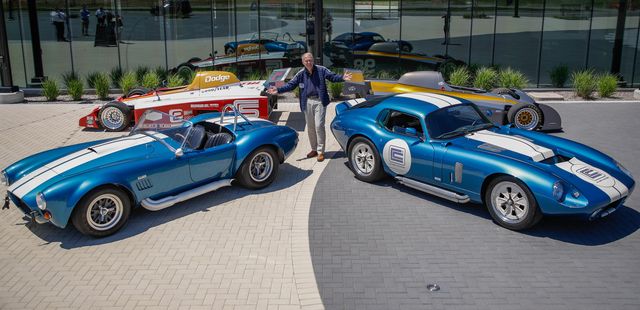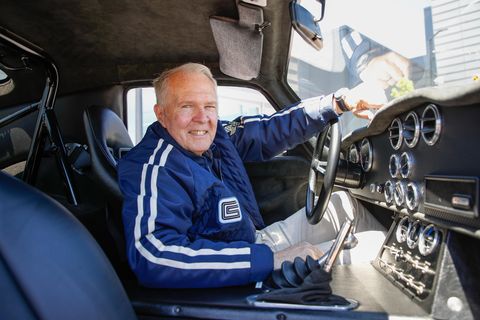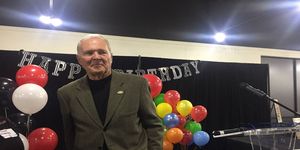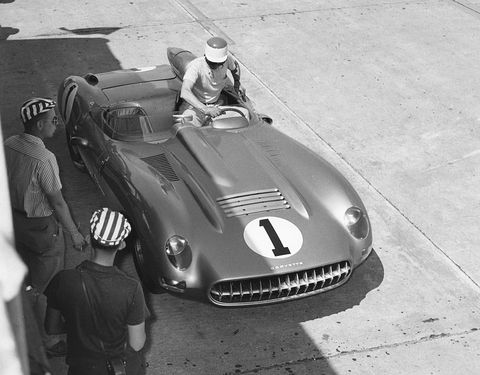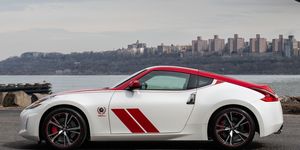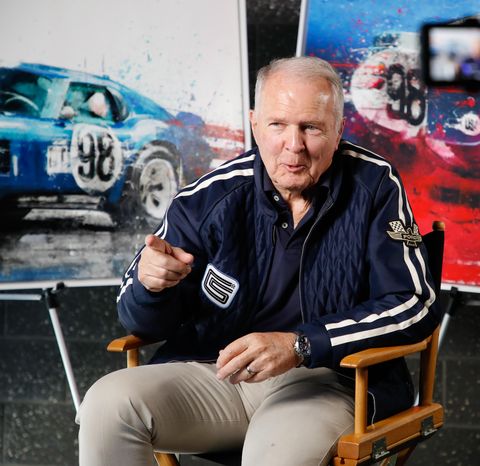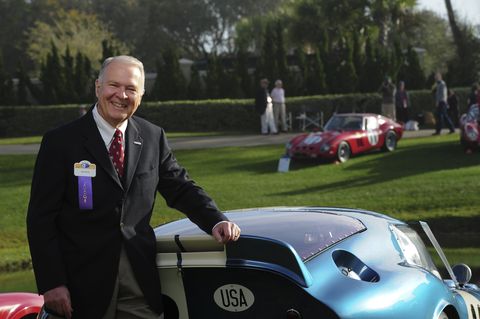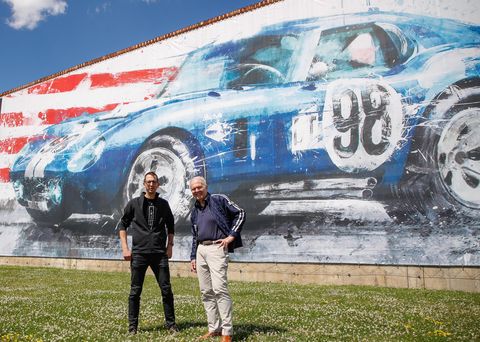- So many questions: At 19, was Peter Brock the youngest designer ever hired by GM? Did he design the ‘63 Corvette Sting Ray, or did Larry Shinoda? What’s it like hang gliding at 15,000 feet?
- Brock and fellow designer Ian Callum have been working in recent years with an Irish company, AVA, to launch a reinterpreted Corvette Sting Ray as an all-electric “hyperclassic.”
- Brock can’t seem to put down his pencil—he’s always sketching, always trying to hatch an idea that might resonate in the automotive market. Stay tuned.
It’s been a big year for Peter Brock: He was inducted into the Motorsports Hall of Fame, accepted the Eyes on Design Lifetime Design Achievement Award, received the Carroll Shelby Spirit Award during Monterey Car Week, and met the grandsons of German aerodynamicist Wunibald Kamm and autographed their copy of Brock’s book about the Shelby DeTomaso P70.
He’s done more media interviews and appeared at more car shows than he can count and has logged a ton of miles, even before he goes to Jakarta next month for the International Datsun Die-Cast show in recognition of the BRE Datsuns that won four national championships for Brock Racing Enterprises in the 1970s.
Before he lands in Jakarta, the 85-year-old Brock will stop in suburban Detroit to serve as Master of Motorsports for the American Speed Festival, to be hosted September 29 to October 2 at the M1 Concourse, a car community and private track occupying land that used to be a General Motors assembly plant in Pontiac. He’ll be the special guest at Saturday night’s $500-per-person charity gala, the Checkered Flag Ball, in honor of Shelby American’s 60th anniversary.
During his whirlwind take-a-bow tour, Brock took time to speak with Autoweek about his long career, his work on the iconic 1963 Chevrolet Corvette Sting Ray, his motivation behind creating the Shelby Daytona Cobra coupe, and his love for hang gliding, which became much more than a hobby. And even though he’s earned the right to spend his days quietly fishing, golfing, or playing cards, Brock can’t seem to put down his pencil—he’s always sketching, always trying to hatch an idea that might resonate in the automotive market. Stay tuned.
After so many achievements, Brock enjoys talking about the past, but he often prefers to reflect on those who inspired him and those he teamed with over the year. When asked if it’s true he was the youngest designer ever hired by General Motors—19 years old in 1956, while attending Art Center School in California—Brock deflects and says he actually thinks Robert Cumberford was a few weeks younger when he worked at GM.
“So, you know, he’s pointed that out a couple of times,” Brock says of his longtime colleague, then offering him praise. “Bob is probably one of the best critiques of design—in his writing, his journalistic stuff—he’s done a tremendous job over the years.”
Brock is grateful for and will never forget his formative years working at GM—for about two years, under Bill Mitchell as he succeeded another design icon, Harley Earl, who retired as GM’s design chief in 1958.
“I mean, who, who gets that opportunity when they’re 19 years old, to work under the direction of the guy that probably had the greatest era of design ever—American automotive design,” Brock says.
It was Mitchell who saved the Corvette from the scrap heap at a time when the company bean counters wanted to kill it off due to poor sales after launching in June 1953. Ford launched the Thunderbird the following year, and at one point it was outselling the Corvette 15 to 1.
“The T-bird annihilated them,” Brock recalls. “I mean, they had an all-steel car with roll-up and down windows with air conditioning, heat, everything an American likes in a nice personal car.”
With GM management short on patience, Harley Earl had one more idea: emulate the European model for a super race car version of the Corvette that would get people excited. Zora Arkus-Duntov led the Corvette SS program, and Robert Cumberford was part of the design team. The car ran in the 1957 12 Hours of Sebring and retired after 23 laps due to overheating and brake and suspension troubles.
That’s not the kind of publicity the Corvette team was looking for.
“Management came in and killed the entire Corvette program and said, ‘Okay, that’s the end of it. No more Corvette Racing and no more production,’” Brock says.
This happens while Earl is passing the design baton to Mitchell, who wasn’t ready to quit on the Corvette.
“Bill said, ‘Bullshit, we’re going to continue with the car,’” Brock recalls, but the work on a second-generation Corvette had to be done in secret, and Mitchell had identified the young talent (including Brock, Gene Garfinkle, Norm Neumann, Chuck Pohlmann, and studio head Bob Veryzer) to do the work, not in the Chevrolet studio but in Research Studio B in a basement at GM’s Warren, Michigan, technical center.
Mitchell had been to the 1957 Turin auto show, “where he’d seen all these little streamliners,” such as the Alfa Romeo Disco Volante. “Mitchell saw that car and said, ‘That’s the car’” that would inspire the next Corvette and handed over photographs to Brock and the other young designers to start working.
“He was just putting this out as an idea to see if it worked,” Brock says of Mitchell. “And the longer he went on it, the more enthusiastic he got about it. And I ended up being the lead designer on the project. He liked what I was doing, so we built up a scale model on it. And he loved that and said, ‘Okay, we're gonna make the full scale.’ So we did the full scale on it. And Mitchell says, ‘Okay, we’re gonna build that.’”
And that was the beginning of the second-generation Corvette, which didn’t launch until 1963—about five years after Brock had left GM—and Larry Shinoda gets most of the credit. But the major inspiration for Shinoda was Brock’s sketch, which Mitchell liked and urged the team to further develop.
“If you look at the (production) ‘63, it’s this car,” Brock says of his sketch. “I mean, it’s everything on it.”
Remember how Brock doesn’t like to rest? He and fellow designer Ian Callum have been working in recent years with an Irish company, AVA, to launch a 1963 Corvette Sting Ray replica as an all-electric “hyperclassic.”
After leaving GM in 1958, Brock returned to California (he grew up near Sausalito) and rekindled his love for motorsports. At 16, he had saved his money to buy a 1949 MG, and then soon after a 1946 Ford convertible nicknamed the “Fordillac” for the Cadillac engine Brock had installed.
Upon returning to California, he was working at a garage and spent his evenings fixing up a 1950s Cooper he planned to race.
In 1961, Brock was hired by Carroll Shelby as employee No.1 of the newborn Shelby American brand. Brock ran the Carroll Shelby School of High Performance Driving and worked at Shelby American until 1965 designing logos, merchandise, ads, and car liveries, as well as the Shelby components of the Shelby Mustang GT350s. More importantly, he designed Shelby American race cars, including the De Tomaso P70 and the Shelby Daytona Cobra coupe.
“The car was so radically different at the time that there was a lot of resistance to the design,” Brock says of the Daytona Cobra. At 26, he was the youngest guy in the shop at the time, and he had an idea about converting the AC Cobra roadster for racing in Europe.
“I said, ‘There is a loophole in the rules that will allow us to take the body off the roadster and put a new body on it.’ And I said, ‘I can design a car with so little drag that we can take the same exact chassis underneath, and we can go from 160 miles an hour to almost 200.’ I said, ‘I can guarantee it will do at least 180.’”
Carroll Shelby gave the greenlight, and the Shelby Daytona Cobra coupe was born. “We went over to Europe, and we just absolutely obliterated everybody with it,” Brock says of the car he designed that won the FIA GT World Championship in 1965.
“Winning the world championship with that, especially when we went out and beat Ferrari, who had been dominant for so many years—and to do it with an American production engine—it was really, really satisfying,” Brock recalls.
Brock probably needs to add a wing to his house in Henderson, Nevada, to display all the trophies, plaques, engraved cups, and other special accolades that have come his way for a truly storied career as a designer, photographer, and motorsports ground breaker.
And at 85, he still enjoys Kart racing.





